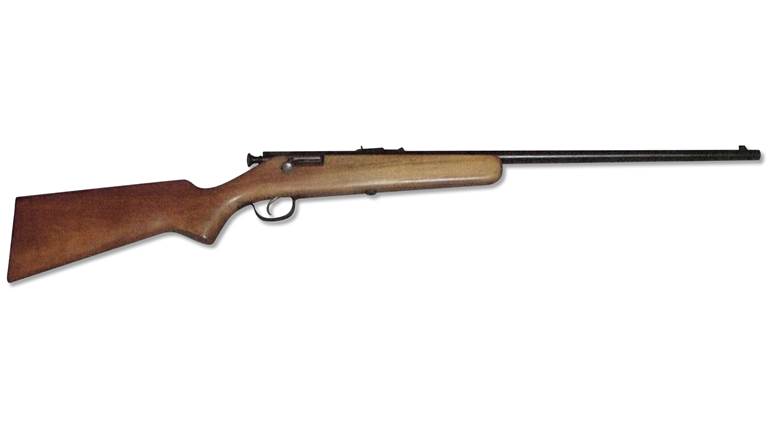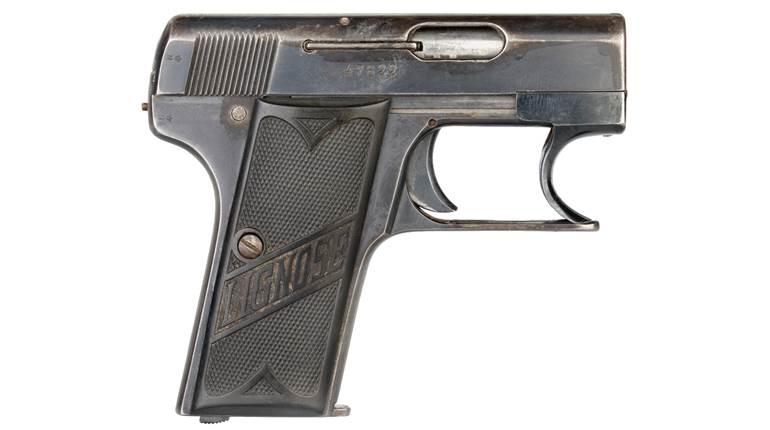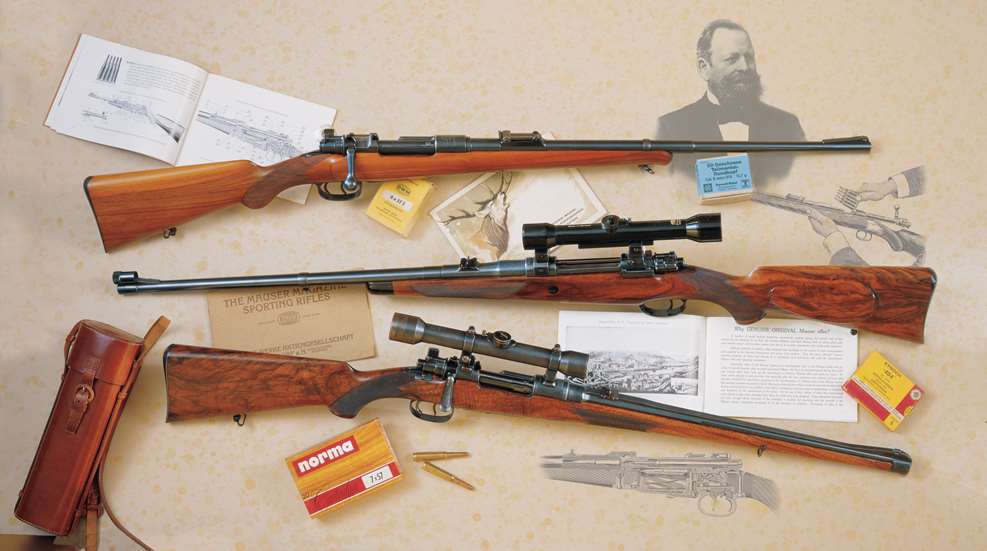
This article appeared originally as "A Century Of The Mauser 98" in the July 1998 issue of American Rifleman. To subscribe to the magazine, visit the NRA membership page and select American Rifleman as your member magazine.
The great success of the Mauser 98 rifle is due chiefly to its well-designed turnbolt action developed by Paul Mauser. Millions of Mauser military and sporting rifles and carbines with actions of original or slightly modified Mauser 98 design have been produced. The military versions were mostly replaced by semi-automatic and automatic rifles, but sporters with Mauser 98 actions are still going strong. In addition, other turnbolt rifles of various makes and models have actions based generally on the Mauser 98. Mauser enthusiasts often express their feelings on the matter with the phrase: “It’s the one they all copied.”
In accordance with German military practice, the Mauser 98 rifle was officially dubbed Gewehr (Rifle) 98 for the year of its adoption. A longer designation was Infantry Rifle 98. The name Mauser 98, in honor of Paul Mauser, is used commonly in lieu of military designations. It is a generic term for a rifle or carbine with the Mauser 98 action or for the action alone. The term Model 98 is also used.
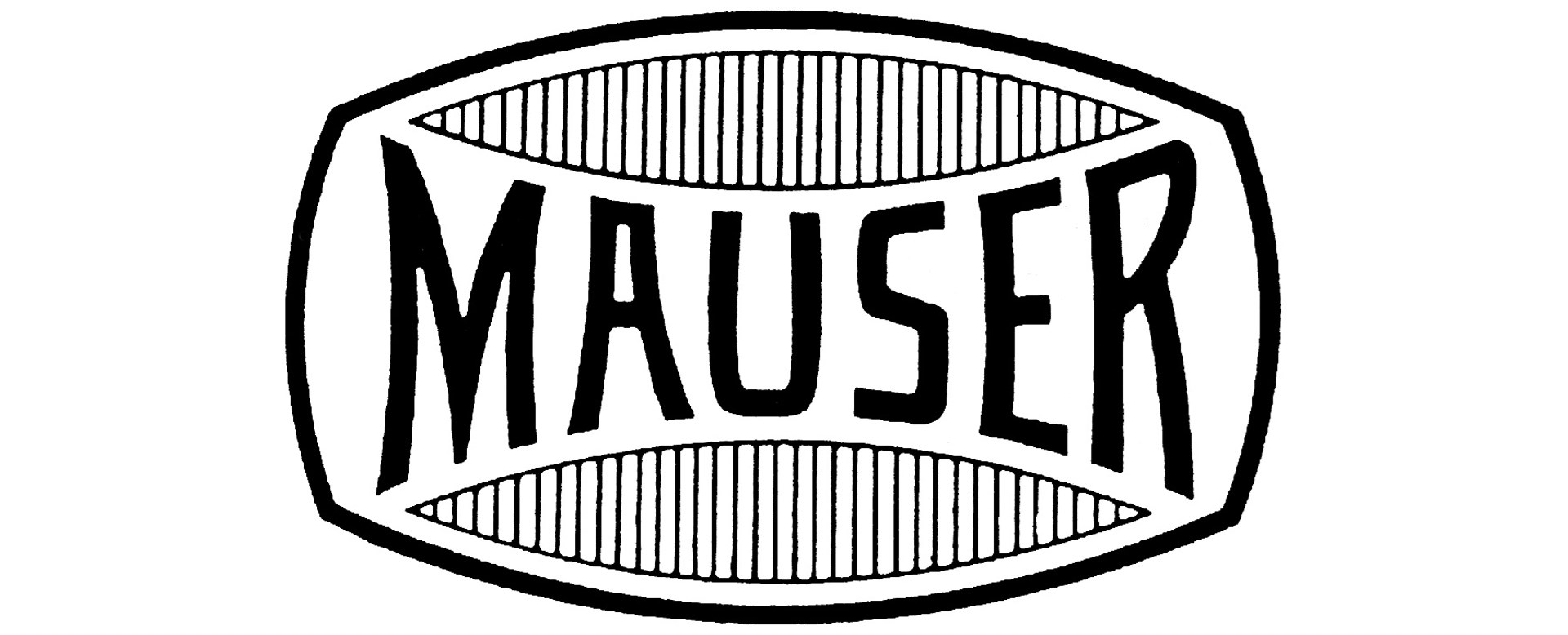
Paul Mauser developed a series of smokeless-powder magazine rifles introduced from 1889 to 1897, and many improvements in those rifles were carried over into the Rifle 98.
In 1888, Germany adopted the 7.9 mm Rifle 88, often called the “Commission Rifle” because it was developed by the Rifle Testing Commission at Spandau Arsenal. Several serious faults of that rifle showed up during use by troops. It was clear that a new rifle of foolproof design was needed. German authorities were favorably impressed with the 7 mm Mauser Model 93 rifle adopted by Spain. That led to German tests of Mausers in various calibers and, finally, to adoption of the Rifle 98 in 7.9 mm.
The simple and reliable action of the Rifle 98 set the pattern for others in the Mauser 98 family and did much to make the name Mauser virtually synonymous with bolt-action rifles.
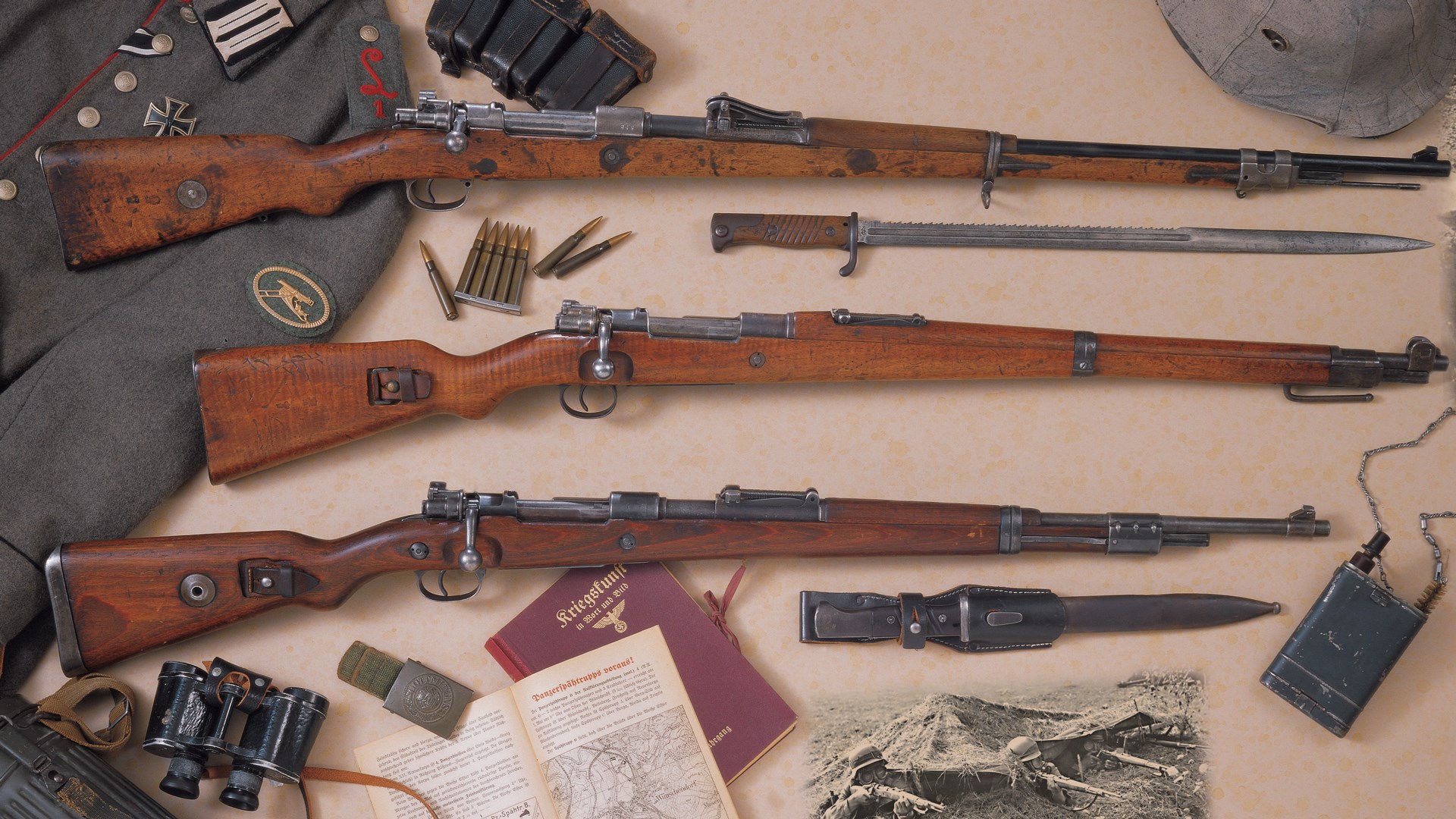 Mauser 98s in 7.9 mm served the German military for the first half of this century. The first was the Rifle 98 (top), and this example was made at Danzig in 1906. The Carbine 98a (center) saw use during World War I. The 98a pictured was made by Erfurt in 1915. The Carbine 98k (below) was the “backbone” of the German army in World War II. Compilation of images and gear courtesy of Glenn M. Gilbert, Philip Schreier, Interarms and National Archives.
Mauser 98s in 7.9 mm served the German military for the first half of this century. The first was the Rifle 98 (top), and this example was made at Danzig in 1906. The Carbine 98a (center) saw use during World War I. The 98a pictured was made by Erfurt in 1915. The Carbine 98k (below) was the “backbone” of the German army in World War II. Compilation of images and gear courtesy of Glenn M. Gilbert, Philip Schreier, Interarms and National Archives.
Among the most important Rifle 98 features are its loading system and box magazine. Expendable five-round strip clips, also called chargers, are used to load the magazine from the top. With the bolt open, a clip of cartridges is inserted in guideways on the receiver, and the rounds are pushed down into the magazine. The empty clip is ejected automatically while closing the bolt. Loose rounds can also be loaded into the magazine. The Mauser clip-loading system gives the important advantage of increased firepower.
The fixed box magazine with staggered cartridge column is flush with the underside of the stock. It is closed at the bottom by a floorplate that can be detached easily for cleaning. The magazine box and trigger guard form an integral unit called the guard. It is fastened to the receiver by two guard screws.
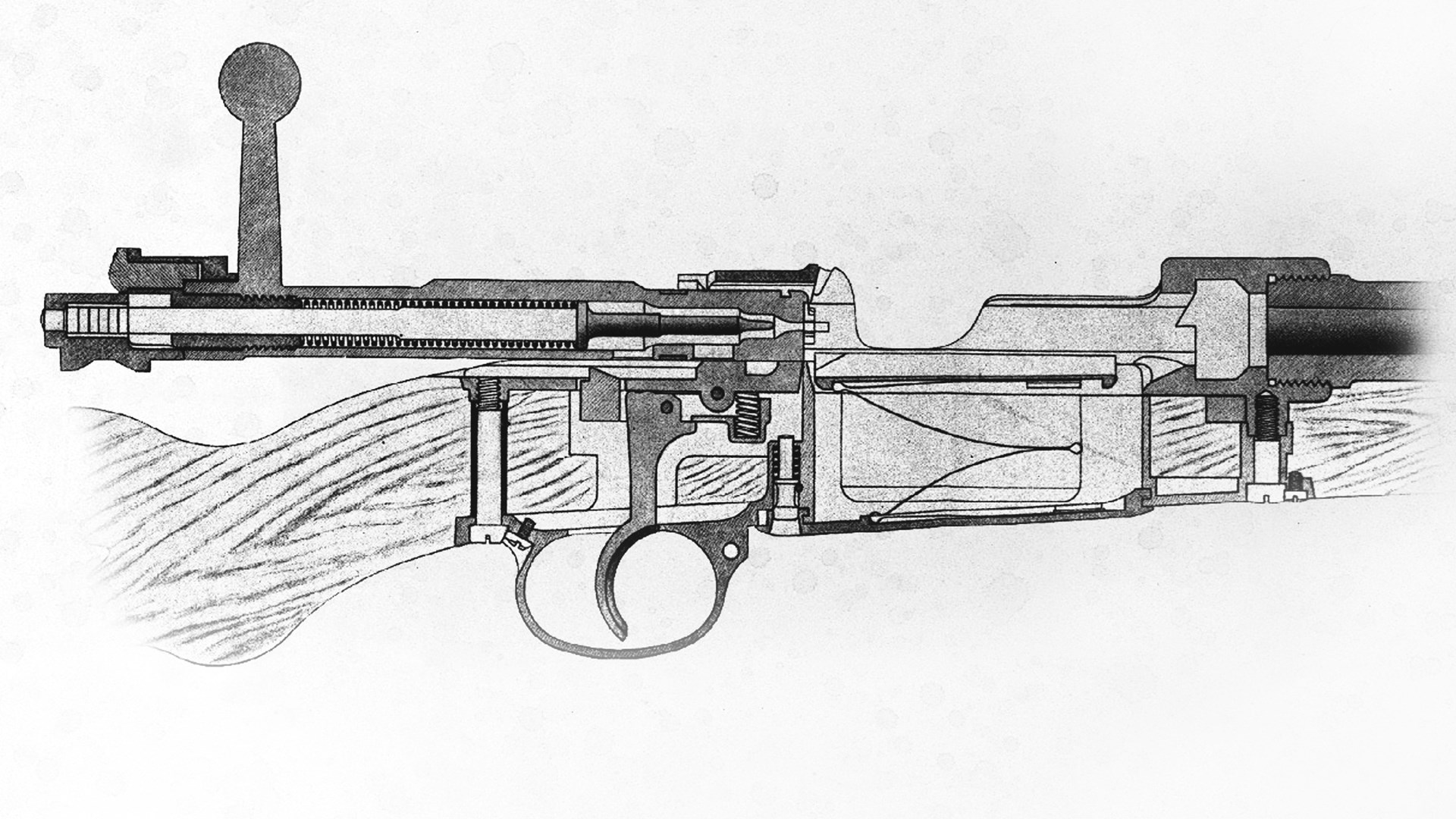
Another important feature is the simple and strong one-piece bolt with dual-opposed front locking lugs that engage shoulders in the receiver ring. That system gives less receiver stretch and bolt compression than rear locking. Mauser claimed that symmetrical support with dual-opposed lugs helped obtain the best accuracy.
A safety lug at the rear of the bolt protects the shooter should the front locking system fail. It is often erroneously called a third locking lug, but it actually clears the locking shoulder in the receiver.
The bolt is bored out from the rear to receive the firing mechanism consisting of the bolt sleeve (also called bolt plug), one-piece firing pin, cocking piece and coil mainspring. A half-turn leaf safety and spring-actuated bolt sleeve lock are fastened to the bolt sleeve.

Drawings of an Oberndorf Mauser sporter show the rifle’s loading sequence. The bolt is opened; a loaded clip is inserted into the clip slots at the front of the receiver bridge; cartridges are pushed down into the magazine with the thumb; and the bolt is pushed forward, feeding a cartridge and automatically ejecting the clip.
A simple two-stage trigger mechanism is pivoted on the receiver. Preliminary pull of the trigger, called slack, levers the sear downward almost out of contact with the cocking piece. The point of leverage is then transferred from the forward hump on the trigger to the rear hump, and the remaining pull causes the cocking piece to be released. That gives sufficient safety for rough handling of the rifle combined with a relatively easy final trigger pull.
Unlike several of today’s bolt-action rifles, the Rifle 98 does not feature a speed lock. Its fairly heavy firing pin and cocking piece plus the half-inch firing pin stroke are designed to give sure-fire performance under rugged field conditions in mud, sand and extreme cold. The heavy cocking piece helps the firing pin support the primer during the period of high pressure.
Cocking of the firing mechanism occurs chiefly while opening the bolt. The bolt diameter is increased at the rear where the cocking cam is located. That causes the cam to turn on a larger radius so that cocking is eased. An extraction cam on the root of the bolt handle helps loosen the fired cartridge case from the chamber. Seating the cartridge in the chamber and completion of cocking are assisted by locking cams.
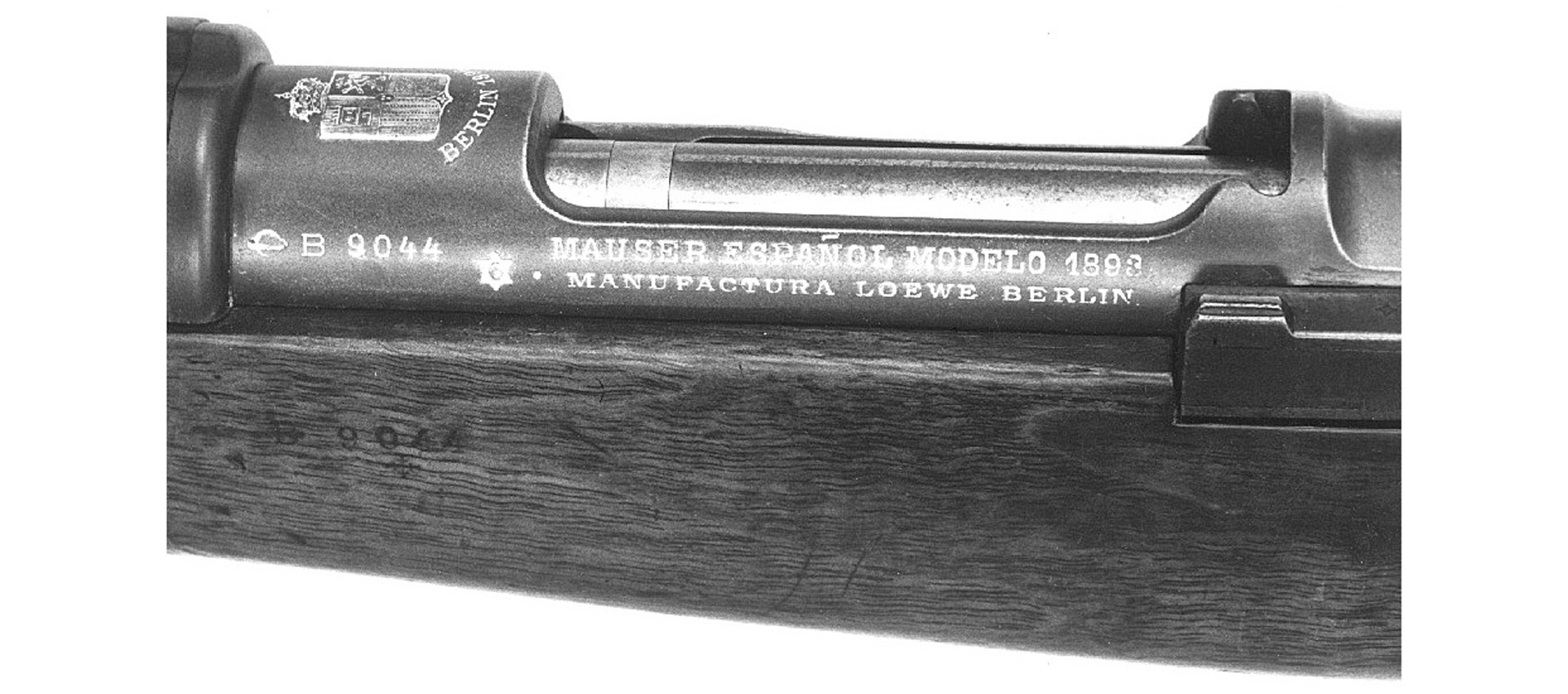
From 1889 to 1897, Mauser developed a series of smokeless powder rifles—mostly for export—and many improvements to those rifles were incorporated into the Model 1898. One typical rifle was the Spanish Model 1893 as produced by Loewe.
The long non-rotary extractor, fastened to the right side of the bolt by an extractor collar, gives controlled-round feeding by engaging the case rim to hold the cartridge on the bolt face from the time the round leaves the magazine until the fired case is ejected. That results in a big plus for foolproof functioning, very important in a military arm and also in sporters used for hunting dangerous game.
When the bolt is fully to the rear, it has considerable sideward wobble due to generous lateral clearance and short bearing in the receiver. That gives an impression of sloppy workmanship, and many shooters claim that it causes the bolt to bind. Offsetting those drawbacks, the side clearance allows for some receiver warpage during heat treatment and contributes to reliable functioning in the presence of sand, dirt and mud.
As the bolt is pulled rearward, the spring-actuated ejector enters a slot in the left locking lug and ejects the cartridge case out to the right. The ejector and bolt stop are fastened on the left side of the receiver by a screw.
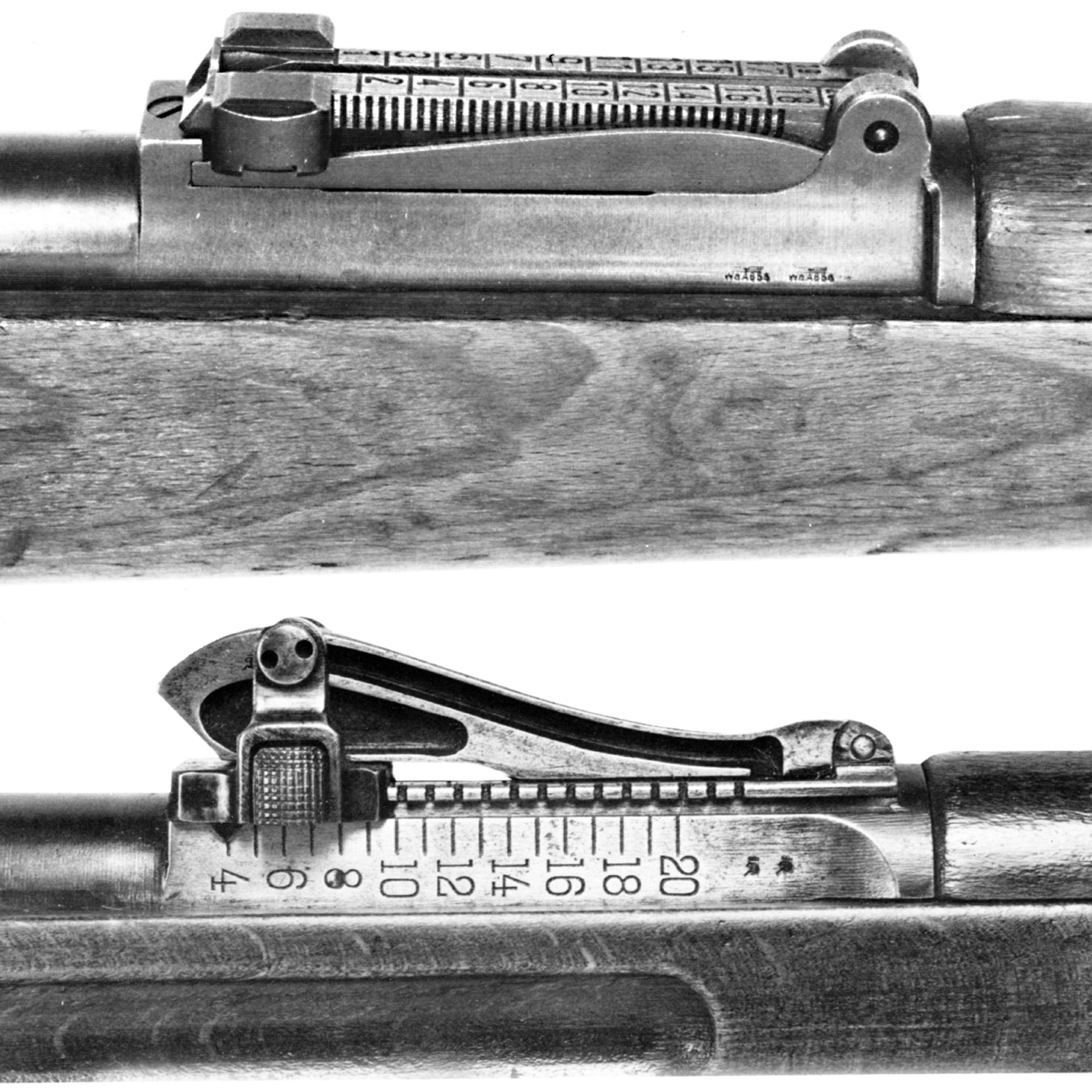 Tangent curve rear sight on World War II vintage 98k Carbine (top) features elevation adjustments from 100 to 2000 meters. Lange rear sight (bottom) on Model 98 rifle designed for use with S cartridge ranges from 400 to 2000 meters.
Tangent curve rear sight on World War II vintage 98k Carbine (top) features elevation adjustments from 100 to 2000 meters. Lange rear sight (bottom) on Model 98 rifle designed for use with S cartridge ranges from 400 to 2000 meters.
The bolt handle, located conveniently at the rear of the bolt, is disliked by many riflemen because it projects horizontally. According to the British Textbook of Small Arms (1909), the horizontal bolt handle comes easily to the hand without the eyes being taken off the target. It can also be readily hit from the bottom to ease extraction. However, the horizontal handle is not as compact and neat as a turned-down handle, is more likely to be pushed up accidentally, and many shooters find that it makes bolt operation awkward when firing from the shoulder.
The receiver ring is 1.41" diameter, somewhat larger than the rest of the receiver. That strengthens the receiver in the locking area. Additional strength is provided by a collar integral with the receiver ring’s interior. The collar is slotted on the right to clear the extractor. Otherwise it is a close fit with the cylindrical bolt head to give a shrouded effect and help prevent rearward escape of gas in event of a ruptured cartridge.

Pre-World War I German 7.9 mm Rifle 98.
Two large oblong holes in the left side of the bolt allow escape of gas entering the bolt through the firing pin hole. The gas can then drive rearward through a deep rounded cut in the receiver’s left side. Another purpose of the cut is to provide thumb clearance when loading the magazine. A gas shield at the front of the bolt sleeve also helps protect the shooter.
Deep seating of the cartridge in the chamber to support the case in its critical head area is an important but often overlooked safety feature. Only 2.8 mm (0.110") of the case head projects from the chamber of the Rifle 98 when the round is seated.
Paul Mauser improved the Rifle 98 a few years after it was introduced. German patent 154915, dated May 22, 1901, described a safety firing pin with diametrically opposed lugs on the front of its mainspring flange. The lugs align with shoulders in the bolt when the action is unlocked. According to the German patent, this feature prevents firing if the firing pin would break when the bolt is open.
The Rifle 98 was produced in large quantity by the Mauser Co., several other commercial firms and German arsenals (Spandau, Danzig, Erfurt and Amberg). Mauser and its parent firm, DWM in Berlin, were the most important commercial producers. (DWM stands for Deutsche Waffen-und Munitionsfabriken A.G.; German Arms and Ammunition Co., Inc.)
 Post-World War I German 7.9 mm Carbine 98b.
Post-World War I German 7.9 mm Carbine 98b.
A short 7.9 mm carbine with Mauser 98 action was also adopted by the German Army. Stocked to the muzzle, it is only 37.4" long and has a flat, turned-down bolt handle to fit a saddle scabbard. Some specimens have replacement bolts with round bolt handle knobs.
The 7.9 mm S cartridge with spitzer bullet, adopted by Germany in 1903 and ready for issue in 1905, gave excellent results in the Rifle 98 with its 74 cm (29.13") barrel, but produced excessive muzzle blast and flash when fired in the short barrel of the carbine.
In 1908, a longer carbine with 60 cm (23.62") barrel was adopted. It was called Karabiner 98AZ. (AZ stands for Aufpflanz und Zusammenstellvorrichtung; a means for fixing bayonet and stacking arms.) The AZ was dropped from the designation in 1912. This carbine is actually a versatile short rifle. One of its peculiar features is a turned-down bolt handle with the inner side of the knob flattened and knurled. Another is a small receiver ring of 1.30" diameter. It was issued to cavalry, foot artillery and special troops. Used extensively during World War I, it also saw service after that war when it was renamed Karabiner 98a.
Shortly after the turn of the century, many nations in addition to Germany adopted rifles and carbines with Mauser 98 actions. They were in various calibers, principally 7 mm and 7.65 mm, and had a number of different model designations. Mauser, DWM and the Austrian Arms Co., Steyr, Austria, were the leading producers. Turkey was one of the best customers. Others were China, Siam, Serbia, Mexico, Costa Rica and several South American nations.
 World War II-vintage German 7.9 mm Carbine 98k.
World War II-vintage German 7.9 mm Carbine 98k.
Due to restrictions placed on German production of military arms by the Versailles Treaty, manufacture of military Mausers was largely taken over during the 1920s and 1930s by Fabrique Nationale (FN) of Herstal, Belgium, and Cesko-slovenska Zbrojovka (Czechoslovakian Arms Factory; abbreviated CZ), Brno, Czechoslovakia. Mausers produced by those firms were in several calibers and had various designations, but all had Mauser 98 actions. They were sold to nations in Europe, Asia, Africa, Central America and South America. Government arsenals in Poland, Yugoslavia, Spain, China and other countries also produced rifles with Mauser 98 actions.
After World War I, The German Rifle 98 was modified by fitting an increased-width lower band and improved rear sight with flat leaf. A long carbine called Karabiner 98b was also adopted. Despite its carbine designation, it has the same 74-cm barrel length as the rifle to avoid muzzle flash when firing the heavily loaded S cartridge. It also has a turned-down bolt handle.
The Mauser Co. developed a Model 98 short rifle around 1924 called the Standard-Modell. Featuring a 60-cm barrel and horizontal bolt handle, it was offered commercially in 7.9 mm, 7 mm or 7.65 mm. It was later sold to China and various other countries.
In 1929 and 1930, the German Army tested Mauser Standard-Modell short rifles and 98b carbines with barrels shortened to 60 cm. The shortened 98b proved to be handier, very likely because of its turned-down bolt handle, and was favored for adoption. It was found that the 7.9 mm sS cartridge with spitzer-boattail bullet gave less muzzle flash than the S cartridge, and was suitable for use in short rifles. (sS stands for schweres Spitzgeschoss; heavy-pointed bullet.)
 Early, original Mauser 8x57 mm Sporter with two-stage single trigger and rounded bottom pistol grip.
Early, original Mauser 8x57 mm Sporter with two-stage single trigger and rounded bottom pistol grip.
The new carbine was given the name Karabiner 98k (k is for kurz, meaning short.) Hitler disregarded the Versailles Treaty, and the 98k was officially adopted in June, 1935. Limited production was started in 1934. As standardized for production, the 98k featured a Mauser-designed single barrel band retainer that secured both upper and lower bands. Mauser and many other firms produced the 98k in tremendous quantity until the German collapse in 1945. Some were made following the war during the French occupation of the Mauser Co. in Oberndorf a/N.
Mauser 98 sporters run the gamut from economy versions converted from military rifles to elegant and expensive specimens in the Rolls-Royce category. The most noted producer was the Mauser Co. Sporters offered by that firm from about the turn of the century until the end of World War II were made in rifle and carbine models with a wide choice of calibers and various action lengths from short to magnum. Called original Mauser sporters, they were available with many extras, and were actually custom guns.
There are many other makers of Mauser 98 sporters in Germany, the United States and other countries. Some custom sporters are made from scratch, action and all, and are priced to ruin almost any bank account.
The Mauser Co. made paramilitary Mauser 98 target rifles similar in appearance to the German Rifle 98. Most were in 8.15x46R. They were discontinued at the end of World War II and are now much sought after by collectors.
 Home-made sporter made from a 98k with a buttpad and cut-down fore-end.
Home-made sporter made from a 98k with a buttpad and cut-down fore-end.
Mauser officials told me many years ago that they decided not to resume production of the Mauser 98 action following World War II because of high manufacturing costs. In recent years, the Mauser Co. introduced Model 98 sporters that have selected military actions. They are made in popular German and U.S. calibers.
There is considerable speculation by collectors and others as to how many Mauser 98 rifles and carbines were produced. Estimates vary greatly. Production figures can only be approximate due to loss of records and other factors. The German Carbine 98k was produced in especially large quantity. An estimate of its total production from 1935 through May, 1945, is 12.8 million. Sporter production was far less. Roughly 127,000 original Mauser Sporters, also called Oberndorf Mauser Sporters, were turned out from the turn of the century until the end of World War II.
Although the Mauser 98 has reached the ripe old age of 100, it still provides great fascination for collectors, shooters and gunsmiths and will likely continue to do so. Its impact on the basic design of various other turnbolt rifles is tremendous. It is a classic that deserves an honored place in the firearms hall of fame.
About the author: Ludwig Olson should be familiar to longtime readers of American Rifleman. Olson joined the NRA Technical Staff in 1957 and wrote numerous articles for Rifleman, and he eventually became Technical Editor. He retired in 1976. His book, Mauser Bolt Rifles, is regarded as the foremost work on the subject.
Special thanks to the late Alex Mauser, son of Paul Mauser, Fred Reigle, Dipl.-Ing. Wolfgang Seel, Albrecht Wacker and others who furnished information and photos.












